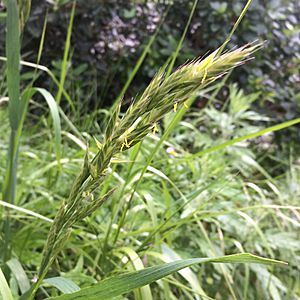Maritime brome facts for kids
Quick facts for kids Maritime brome |
|
|---|---|
 |
|
| Scientific classification | |
| Genus: |
Bromus
|
| Species: |
maritimus
|
| Synonyms | |
|
|
Bromus maritimus is a type of brome grass often called maritime brome or seaside brome. This special grass grows naturally along the coasts of California and Oregon in the United States. It's a tough plant that can handle the salty air and sandy soils found near the ocean.
Contents
About Maritime Brome Grass
Maritime brome grass is a plant that grows in clumps. It's part of the large grass family, which includes many plants we see every day. This grass is known for its ability to live in coastal areas. It helps to hold the soil in place, which is important for preventing erosion on beaches and dunes.
What Does It Look Like?
This grass usually grows to be about 1 to 3 feet (30 to 90 centimeters) tall. It has long, narrow leaves that are often a greenish-blue color. The leaves can feel a bit rough to the touch.
The plant produces flower heads that look like loose, branching clusters. These clusters hold the seeds of the grass. The seeds are important for the plant's reproduction.
Where Does It Live?
Maritime brome grass is native to the western coast of North America. You can find it growing in coastal California and Oregon. It prefers sandy soils and areas that get a lot of sun. This grass is often found on sand dunes, bluffs, and open coastal prairies. It's well-adapted to the unique conditions of these seaside environments.
Life Cycle of Seaside Brome
Like many grasses, seaside brome grows from seeds. It's a perennial plant, which means it lives for more than two years. It can grow back each year from its roots.
The plant flowers in the spring and early summer. After flowering, it produces seeds. These seeds can then fall to the ground and grow into new plants. This helps the grass spread and create new patches along the coast.
Why Is This Grass Important?
Maritime brome grass plays an important role in its ecosystem. It helps to stabilize sandy soils, especially on dunes. This prevents the sand from blowing away in the wind. It also provides food and shelter for small animals and insects that live in coastal areas.
This grass is a natural part of the coastal plant communities. It helps to keep these unique environments healthy and balanced.

